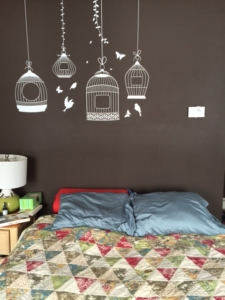No matter how old you are, when your back hurts you feel ninety. Joe Pilates said, “If your spine is inflexibly stiff at 30, you are old. If it is completely flexible at 60, you are young.” I don’t normally suffer from back pain, but a few years ago, I had an ache in my low back that wouldn’t go away. Nothing calmed it. This was especially frustrating since I teach Pilates and I pride myself on knowing what is going on in my own body. I understand a lot about what causes pain and how movement can help unravel it. I stretched, massaged it, and did exercises. They were the right things to do, but nothing helped for a prolonged period. Nothing stopped the chronic pain.
I’d been dealing with the problem for a couple months when I went to visit my best friend Julie in Chicago. Before my arrival, she mentioned taking a bike ride or doing a program that was like P90x. I told her that was probably unlikely. But after one night in her bed I woke up with zero back pain. We did P90x the next morning. We rode DIVVY bikes around Chicago all afternoon because it turns out I’m inept when it comes to manipulating a bike. So the ride that was supposed to take thirty minutes took three hours. That kind of makes sense if you know my history. As a kid we lived on a busy road so my parents, in order to protect us from motor vehicles whizzing by, spray painted a white line at the end of the driveway. I wasn’t allowed passed it. That meant bike riding was limited to small circles in the driveway. As it turns out, I never really grew to enjoy bikes.
But through all our revelries in Chicago—the intense interval workout and the endless pedaling in the city–my back was completely fine. Though relieved, I wasn’t really sure what finally worked until I got home and woke up in my own bed. Getting out of bed my first morning back made me feel like I’d aged fifty years overnight. It was the bed.
It didn’t take long for us to get another bed. Flash forward about a year and a half and I was experiencing back pain again. Once again, I couldn’t figure out the problem. Our bed was still what I would consider new, so I wasn’t blaming the mattress. Just like last time, nothing seemed to resolve it. As if I was living in Groundhog Day, I went to visit Julie again and after one night in her bed, I was pain free. It was almost too good to be true and a little unbelievable. But purchasing a new bed every couple of years isn’t a realistic option.
Apparently, when it comes to sleeping I am the living version of the Princess and the Pea or Goldilocks—pick your favorite fictional character who has trouble finding the perfect bed. So we looked into a Sleep Number Bed. These are expensive, and I remember telling Matt that if this didn’t work, I’d be really annoyed. This would be a lot of money to dump on a bed if I needed a new mattress in sixteen months. I didn’t want to spend that kind of money on a bed and need to replace it every couple of years. I was generally overwhelmed by the prospect of needing a new bed bi-annually. And, I felt a little like a snob. My two-year-old bed isn’t good enough for me. We’d always bought reputable brands. I didn’t get our mattress used. And they were always comfortable. There was never a point where I got a signal the mattress could be the culprit.
So far the Sleep Number is working for me. When my back starts to bother me, I simply change the setting. I’m not trying to sell you on a Sleep Number. I have no affiliation with them. I’m just sharing my story.
Particularly because it got me wondering how many people could make one change, as simple as their mattress, and get rid of chronic, unexplained pain? It can be an expensive gamble, but it sure seems worth considering if you have been living with pain for a prolonged period and nothing seems to fix it.
Just Beds or Something Else:
When it comes to pain, it could be more than your bed and back. I had a pair of sneakers that I ran in for months. I wore them to walk one day and after about a mile had terrible pain in my Achilles tendon on one side. This was an obvious connection. I’d worn them one day in Chicago while visiting Julie, apparently she has to suffer all my incidents of pain with me. The pain was so sudden and severe, I couldn’t walk. I pulled the shoe off my right foot and walked barefoot through the streets of Chicago. It was almost unimaginable how quickly I became in pain without having done anything to hurt myself. But it made it obvious the shoes were the problem. I never wore the shoes again, not even to run. Even though they didn’t hurt when I ran, I wondered if they were doing damage I wasn’t noticing.
Similarly, Matt had ankle pain for over a year. His was a little harder to sort out because he alternated between work shoes and none of them caused pain when he wore them, but with a little experimentation, he stopped wearing one pair and his ankle pain disappeared and hasn’t returned months later—unsolvable pain that lasted over a year with no explanation gone practically overnight. One pair of shoes in his small shoe collection seemed to be the perpetrator. Again, I couldn’t help but wonder if, at least in certain cases, pain could be this easy to irradiate for other people. Do we just not stop to think of the materials we put on our body and whether or not our body is comfortable with the shoes, the foam mattress, the tight jeans, the tight pony tail. Perhaps it shouldn’t be a surprise. If we sleep about eight hours a night, then the average person spends a third of their life in bed. How could our sleeping material not affect us? Humans didn’t keep trying to improve the bed because rope and horse hair mattress were so comfortable. Most people probably spend two-thirds of their life in shoes, assuming you have something on your feet when you’re not in bed.
The Research:
Of course, such a simple solution won’t be the answer for everyone. I don’t think the beds I had before were bad, but they certainly weren’t good for me. Clearly my body needs some variety or it gets ornery. And the best bed for back pain may not be what you think. Common knowledge says a firmer mattress is better for people with chronic low back pain, but medium-firm may be the way to go. A 2003 study in Spain revealed that individuals with chronic low back pain who slept on a medium-firm mattress for 90-days experienced less back pain sleeping, rising, and throughout the day.
When you go to look for the perfect mattress, know that the study based the firmness on the European Committee for Standardization’s H(s) scale. The medium-firm mattress was rated (H(s)=5.6). On the scale 1 is the firmest, 10, the softest. So the Goldilocks mattress is pretty much right in the middle at 5.6. Sleep well.
Want more Personal Euphoria?
Follow the Personal Euphoria Facebook page, follow Personal Euphoria on Instagram, and subscribe to the Personal Euphoria YouTube Channel.


[…] your bed be causing your back […]